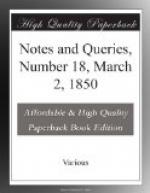The contraction of the compound symbols for the first nine digits into single “figures,” enabled the computer to dispense with the manual labour of the abacus, whilst in his graphic notation he retained its essential principle of place. It seems to be almost invariably forgotten by writers on {280} the subject, what, without this principle, no improvement in mere notation would have been of material use in arithmetic; and on the other hand that the main difference between the arithmetic of the abacus and the arithmetic of the slate, consists in the inevitable consequences of the denotation of the single digits by single symbols.
The abacus, however, in its ordinary form, is essentially a decimal instrument: but its form was also varied for commercial purposes, perhaps in different ways. I never heard of the existence of one in any collection: but there is preserved in the British Museum a picture of one. This was printed by Mr. Halliwell in his Rara Mathematica—not a fac-simile, but a rule and type representation of it, ciphers being used by him for the circles in the original. Mr. Halliwell gives it without note or remark; and evidently had not divined its meaning. This was done, however, soon after in a review of Mr. Halliwell’s book in the Philosophical Magazine. I am not able at this moment to refer to either, so as to give exact dates: but is was somewhere from 1838 to 1840.
Perhaps, however, I am giving “E.V.” information that may be irrelevant to his purpose; though it may of some use to another class of inquirers. I proceed, therefore, to one or two notices that seem to have a more direct bearing on his object:
1. Chasles’ Apercu Historique sur l’Origine et le Developpement de Methodes en Geometrie; passim, but especially in note xii.: 4to., Bruxelles, 1837.
2. Chasles’ several notices in Comptes Rendus des Seances de l’Acad. des Sciences. All subsequent to the “Apercu.”
His Catalogue des Manuscrits de la Bibliotheque de Ville de Chartres should also be consulted, if accessible to “E.V.” Copies of it, however, are very rare in the country, as it was privately printed and never published. If, however, your correspondent have any serious inquiry in view which should render his consultation of it desirable, I can put it in his power to do so personally through you.
3. Libri, several notices in the same series of papers.
4. Libri, Histoire des Sciences Mathematiques en Italie. Several places. Bactulica. Paris, 1838-1841. 4 tomes. 8vo.
5. Peacock (Dean of Ely), “Arithmetic,” in the Encyclopaedia Metropolitana. This is now, I believe to be had either separately, or in the volume devoted to pure “Mathematics.”
6. De Morgan, Penny Cyclopaedia in loc., and occasionally elsewhere in the work.
7. Leslie’s Philosophy of Arithmetic.




